
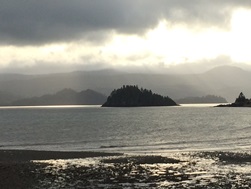 The name Haida Gwaii means Islands of the People. The islands were formerly called the Queen Charlotte Islands until 2010, when the name was officially changed to Haida Gwaii as part of a reconciliation protocol between the Province of BC and the Haida people.
The name Haida Gwaii means Islands of the People. The islands were formerly called the Queen Charlotte Islands until 2010, when the name was officially changed to Haida Gwaii as part of a reconciliation protocol between the Province of BC and the Haida people.
The archipelago consists of are two main islands– Graham in the North, and Moresby in the South, with approximately 150 smaller islands, some of which are protected under the Gwaii Haanas National Park Reserve, a unique agreement signed in 1993 between the Government of Canada and the Council of Haida Nation.
Haida Gwaii has been described as one of the rainiest places on earth, however during my brief stay last January, I experienced lots of sunshine and enjoyed the characteristic, mild temperatures of the region. My visit there was connected to a grant made by the Real Estate Foundation of British Columbia to UBC’s School of Community and Regional Planning (SCARP) in 2011. The grant was made to support an Adjunct Practice Professor position which gives planning students, who generally work in a classroom setting, an opportunity to mentor with an Adjunct Practice Professor experienced in First Nations issues and gives the student planners a practical, hands-on planning experience, working in partnership with host First Nations communities.
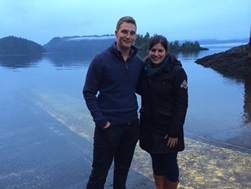 On my first day in Haida Gwaii, I met up with the two UBC Masters planning students, Emma Fineblit and Malcom MacLean (pictured left), who are doing their practicum in Skidegate. I was introduced to members of Skidegate Band Council and members the Land Use Planning team, which consists of the CCP Coordinator, two Planning Assistants and the UBC students. They are currently working on the community’s Comprehensive Community Plan (2012-2017) and Land Use Plan.
On my first day in Haida Gwaii, I met up with the two UBC Masters planning students, Emma Fineblit and Malcom MacLean (pictured left), who are doing their practicum in Skidegate. I was introduced to members of Skidegate Band Council and members the Land Use Planning team, which consists of the CCP Coordinator, two Planning Assistants and the UBC students. They are currently working on the community’s Comprehensive Community Plan (2012-2017) and Land Use Plan.
Afterwards, a special invitation was extended to us to join the Elders for lunch at the Skidegate Haida Immersion Program (SHIP), where participating Elders attend five days a week, ten months of the year to support efforts to revitalize the southern Haida language, Xaayda Kil. The program has produced over 120 instructional CD-ROMS for use at home, schools, the community and off island. It’s an initiative that is being undertaken with tremendous dedication. Our lunch was a wonderful, freshly prepared deer stew, which was caught and cooked by one of the elders, Garry Russ Sr. (pictured below in red).
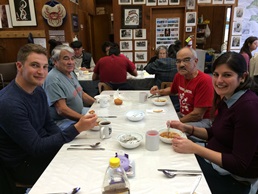 After lunch, Trent Moraes, Skidegate Band Housing Coordinator, invited us out on his boat to experience the beauty of the water and enjoy the spectacular scenery of the area. We were graced by bald eagles and rafts of sea lions, and went on land to visit the site of an ancient Haida Village, Ha’ina Village, of the T’saahl Clan.
After lunch, Trent Moraes, Skidegate Band Housing Coordinator, invited us out on his boat to experience the beauty of the water and enjoy the spectacular scenery of the area. We were graced by bald eagles and rafts of sea lions, and went on land to visit the site of an ancient Haida Village, Ha’ina Village, of the T’saahl Clan.
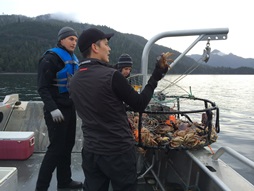 We pulled up two crab traps with enough Dungeness crab to fill a huge cooler, and that evening, we were warmly hosted at the home of Trent and Dana Moraes. Dana is the Skidegate Band Comprehensive Community Plan Coordinator. We feasted on the fresh crab, steamed in seawater, and sampled other local delicacies, including Copper Bay salmon, t’aaw (eulachon grease) and k’aaw (herring roe on kelp).
We pulled up two crab traps with enough Dungeness crab to fill a huge cooler, and that evening, we were warmly hosted at the home of Trent and Dana Moraes. Dana is the Skidegate Band Comprehensive Community Plan Coordinator. We feasted on the fresh crab, steamed in seawater, and sampled other local delicacies, including Copper Bay salmon, t’aaw (eulachon grease) and k’aaw (herring roe on kelp).
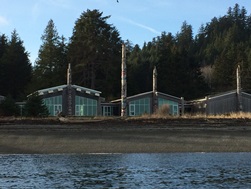 The next day, I visited the Haida Gwaii Museum, a beautiful structure and source of pride in the community, which celebrates the living culture of the Haida with an incredible collection of Haida historical treasures and contemporary art.
The next day, I visited the Haida Gwaii Museum, a beautiful structure and source of pride in the community, which celebrates the living culture of the Haida with an incredible collection of Haida historical treasures and contemporary art.
That afternoon, I attended the community land use-planning meeting, hosted by the planning team. The purpose of this meeting was to gather community input on key governance issues to inform the land use plan, and how the land in Skidegate should be used and governed. About 60 community members, most of whom were Elders attended and rolled up their sleeves to work on helping to identify community policies and actions that would reflect the community’s priorities. I heard stories from the Elders at my table that had grown up on the island. They talked about their traditional ways, and their desire to see these traditional ways carried on by younger generations, now and into the future. Some of the community and land use issues identified included the need for Elders assisted living, concerns about LNG/Enbridge, resource extraction, lack of employment opportunities, teaching traditional land practices to younger generations, the need for better, more equal governance of the land, limited recreational opportunities for children and youth.
I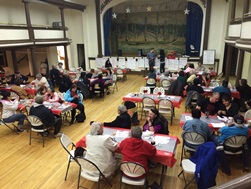 t was clear from that meeting that the community, and in particular the Elders, are very engaged, and willing to come out and to be heard, share their concerns, ideas, suggestions and personal stories. It was also evident that a solid relationship is being built between the local community and the UBC planning cohort.
t was clear from that meeting that the community, and in particular the Elders, are very engaged, and willing to come out and to be heard, share their concerns, ideas, suggestions and personal stories. It was also evident that a solid relationship is being built between the local community and the UBC planning cohort.
On my final morning in Haida Gwaii, I was privileged to attend a meeting of Skidegate Band Council. The Band Council is made up of elected community members who represent and advocate on behalf of the people of Skidegate. Many items were discussed, among them the need to balance economic development with cultural initiatives, and build a resilient local economy, in spite of being denied legal access to many of the islands resources. Milestones of the Comprehensive Community Plan (CCP) were highlighted, and priorities and next steps were discussed. Members of Band Council reflected on the success of this planning process, and the plans that are being developed from it, in it being community, not consultant driven. The draft CCP will be presented to the Community and once the plan is completed and is further along in implementation, there is intention to share the progress will with other First Nations.
It is clear to me that this program is having impact, both on the planning students–who benefit from the hands-on, practical planning experience and the host First Nation communities participating, who benefit from the enthusiasm and skills of the emerging planners.
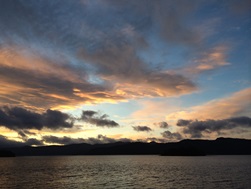 It was an incredible experience to visit this distant region I had learned about as a child, which had always held such wonder for me. Author John Vaillent, in his book the Golden Spruce, describes the islands as a “…kind of soul home… a link to how things were before the arrival of Europeans….” It’s an apt description of a very special place. The striking beauty of the area, warmth and openness of the people, and rich culture and history has left a lasting impression on me.
It was an incredible experience to visit this distant region I had learned about as a child, which had always held such wonder for me. Author John Vaillent, in his book the Golden Spruce, describes the islands as a “…kind of soul home… a link to how things were before the arrival of Europeans….” It’s an apt description of a very special place. The striking beauty of the area, warmth and openness of the people, and rich culture and history has left a lasting impression on me.
– Hedy Rubin
———————————————————————————–
The Real Estate Foundation awarded a $316,723 grant in 2011 to support an adjunct practice professor in Indigenous Community Planning for five years as part of the Indigenous Planning Initiative at UBC SCARP.
All photos by Hedy Rubin.
SHARE